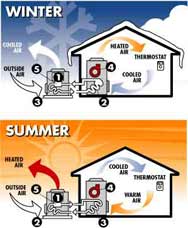
Cools in summer, warms in winter
What makes heat pumps over 300% efficient?
Heat pumps move heat energy from one place to another. When you need extra heating, they remove heat from the outside air, water or ground (geothermal pumps are ones that use water or ground-heat) and deliver it to the house. The reverse happens when you want to cool the house just like a refrigerator.
Heat pumps need energy to move heat from one place to another, and that means electric power, whether from wind, solar or a generator – but little electricity here goes a long way for every unit of electricity used you get 3 or 4 units of heat delivered, making some pumps 300 or 400% efficient.
What do you need for a heat pump?
Firstly, a source of heat you intend to use. Air, water or ground, heat is readily available all around us. Deciding which source you want to use will depend on the climate in your area, and how much you can afford to spend. Geothermal pumps are typically more expensive because their installation involves drilling to get to the water or ground source.
You also need to think about how you’re going to distribute the heat around the house. You can use underfloor pipes, fan coil units, an air handling system, or wall-mounted radiators whatever suits.
As for the system itself, a heat pump will need a power supply either an electric motor or a gas engine (though this is rarer).
Inside the heat pump you have what is called a working fluid that flows through a circuit. The circuit, powered by electricity (or gas), is what delivers heat from the surroundings to the house.
The working fluid changes from liquid to gas (evaporates) as heat is absorbed from the heat source. Later in the cycle, the working fluid condenses to liquid as heat is released to where it is needed.
In this diagram (from: https://www.srpnet.com/energy/pumpworks.aspx)
1. Compressor: The central component of the heat pump, this is usually driven by an electric motor, although gas engine driven compressors are also available. It increases the pressure of the working fluid so that it will accept the maximum amount of heat from the air.
2. Condenser: Coils that move heat to or from the outside air.
3. Evaporator: Coils that move heat to or from the air inside the home.
4. Air handler: Fan that blows the air into the ducts of the home
A heat pump can be used for cooling with the addition of a reversing valve (5) that reverses the direction of the working fluid and so the direction of the heat transfer so you can use the heat pump for air-conditioning in the summer.
How renewable is it?
If heat energy is taken from air, water or ground, and the energy to drive the compressor is electrical, then for every 3 units of heat delivered 2 are renewable. If you produce your electricity using a wind turbine, solar or hydro, all 3 units will be renewable.
The heat taken out of the ground, air or water is replaced by the heat in the atmosphere. So there is no need to worry about depleting the heat supply in the area.
How much does it cost?
This depends on what sort of a system you want. Geothermal pumps are more expensive to install because you need to bore holes in the ground to extract the heat, or have access to a water source. An air pump can be installed on your roof.
On average the price varies from $4,500 to about $7,600 for a domestic installation. In rip-off Britain it is much more expensive – about 5,000 – 7,000A good heat pump can last 40+ years, and running costs during that time should recoup the initial installation spending. Compared to about $2,000 ( or 1,400 in the UK) a year for a gas heater, the total running cost for a heat pump can be $6-700 a year.
ICE ENERGY Heat Pumps (UK) have a number of case studies on their website https://www.iceenergy.co.uk/ comparing running costs and describing installation.
In the US, Water Furnace (https://www.waterfurnace.com/) and FHP Manufacturing (https://www.fhp-mfg.com/residential.htm) both cater for residential water and geothermal pumps. For a more detailed list of manufacturers and installers in the US go to https://www.geoexchange.org/find.htm.

One Response
cool